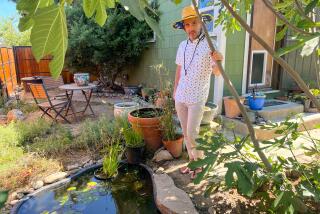From the Archives: Hugels, swales offer DIY rainwater catchment options
It’s fall. Have you hugged your hugel today?
In these years of drought, rainwater catchment makes more sense than ever. Rain costs nothing and is free of hard minerals and chlorine. Plants love it.
The 50-gallon rainwater barrels that were all the rage a few years ago now appear inadequate for many because they’re too small for when they’re really needed, holding barely enough for a few watering cycles. And in Southern California they may not get refilled for months.
“The best storage for rainwater is the ground,” said Rishi Kumar of the Growing Home in Diamond Bar.
A healthy soil, preferably with lots of organic material like compost, can hold several inches of rainwater in the first few feet. And the more stored in the ground, the less you have to add later, particularly for trees and shrubs. Add a few inches of wood chips on top of exposed earth for insulation and the ground stays moist even longer.
Water penetrates deeper and lasts longer if you add swales to your landscape, Kumar said. They are the cheapest and most effective method of harvesting rainwater.
“A swale is a trench with a level bottom,” he said. “It could be two feet deep or six feet deep. It can be open soil but people line them with stones like a dry creek.”
If you do use barrels -- which he doesn’t recommend -- put them near the swale so the barrel overflow goes there.
“I think of it as long-term irrigation. This is the water trees will be pulling up throughout the year.”
Another DIY water catchment technique, often combined with swales, is making a hugel -- a pile of logs or wood, above or below ground. The wood is stacked in a crescent-shaped semi-circle, open toward prevailing ocean winds and, if above ground, covered with dirt. Humidity condenses into the hugel thermal mass and is then released as moisture into the ground nearby.
Leigh Adams is a fan of hugelkultur and has installed mounds in her Altadena backyard as well as at the Los Angeles County Arboretum where she is artist-in-residence. She also curated the Forces of Nature show there in 2012, when local artists used some of the hundreds of trees downed on arboretum grounds by a fierce winter storm. When the show was over she had lots of surplus timber to get rid of. Some wound up in hugels.
She uses dense wood if possible, even eucalyptus, cedar and black walnut. The volatile oils those woods contain will disperse after a year, not affecting the soil.
A hugel gives the ground a chance to capture ambient moisture, functioning like a nurse plant, she adds. It offers protection, shade and water to its neighbors.
“It’s like a Joshua tree,” she said. “It protects smaller plants in its shadow.”
A hugel can also do duty as a raised bed, with different sides having different sweet spots. On the northeast side, for example, winter crops will stay longer.
“You can do a hugel anywhere there’s a breeze,” Adams said.
What if you don’t have downspouts from a roof, as in a community garden or open field, to direct rainwater? One solution is the Rain Saucer, a disk made from heavy-gauge plastic. Looking like an upside-down umbrella, the Saucer (which was field tested in rural Guatemala) unfolds to make a funnel to fill containers with rainwater. The larger version offers nearly 18 square feet of capture area, collecting more than 10 gallons per inch of rain.
Catch-a-Drip is an adapter that harvests the condensation drip from air conditioners, producing up to 10 gallons a day, moving potentially damaging moisture away from foundations. The water collected is then dispersed, a drip at a time, through hoses on a gravity-fed system into the garden.






